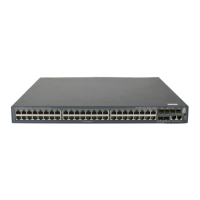146
Configuration prerequisites
Different clients may have different web proxy configurations. For these clients to trigger portal
authentication, you must satisfy the following prerequisites:
Web
rox
confi
uration on clients
Confi
uration
rere
uisites
Scenario 1:
All or some clients use a web proxy, and
the portal server’s IP address is not a
proxy exception.
• If an iMC portal server is used, perform the following
configurations on the iMC portal server:
{ Select NAT as the type of the IP group associated with the
portal device.
{ Specify the proxy server’s IP address as the IP address after
NAT.
{ Configure the port group to support NAT
• The portal server and the web proxy server have IP connectivity
to each other.
Scenario 2:
All or some clients use a web proxy, and
the portal server’s IP address is a proxy
exception.
If an iMC portal server is used, configure the IP group and port
group to not support NAT.
Scenario 3:
All clients use a web proxy server but only
some clients specify the portal server’s IP
address as a proxy exception.
• If an iMC portal server is used, add the client IP addresses to
two IP groups according to whether the portal server’s IP
address is a proxy exception, and then configure the IP groups
and the port group according to scenarios 1 and 2.
• The portal server and the web proxy server have IP connectivity
to each other.
Configuration procedure
Follow these steps to configure Layer 3 portal authentication to support a web proxy:
To do… Use the command…
Remarks
Enter system view system-view —
Add a web proxy server port
number
portal web-proxy port port-number
Required
By default, no web proxy server
port number is configured and
proxied HTTP requests cannot
trigger portal authentication.
NOTE:
• If a user’s browser uses the Web Proxy Auto-Discovery (WPAD) protocol to discover web proxy servers,
add the port numbers of the web proxy servers on the device, and configure portal-free rules to allow
user packets destined for the IP address of the WPAD server to pass without authentication.
• If the web proxy server port 80 is added on the device, clients that do not use a proxy server can tri
er
portal authentication only when they access a reachable host enabled with the HTTP service.
• Authorized ACLs to be assigned to users who have passed portal authentication must contain a rule tha
permits the web proxy server’s IP address. Otherwise, the users cannot receive heartbeat packets from
the remote portal server.
Enabling support for portal user moving

